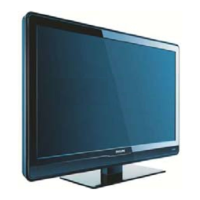
Do you have a question about the Philips Q522.1E LB and is the answer not in the manual?
Details on display type, screen size, resolution, light output, viewing angle, color systems, video playback, tuner bands, and supported formats.
Overview of side and rear connections, including headphone, composite video, S-Video, USB, and HDMI ports.
Identifies the main PWB/CBA locations within the chassis, such as main supply panel, keyboard control panel, IR & LED panel, and small signal board.
Outlines essential safety regulations for repairs, including isolation transformers, safety component replacement, wire routing, and insulation checks.
Covers precautions related to electrostatic discharge (ESD), high voltage sections, and component replacement while the unit is powered on.
Explains general measurement guidelines, schematic conventions, BGA IC handling, and lead-free soldering practices.
Illustrates the correct routing and management of internal cables within the TV set for proper assembly and maintenance.
Details the recommended service positions for easy access to internal components, including the use of buffers and foam bars.
Provides step-by-step instructions for removing the rear cover, speakers, IR & LED board, key board, display supply panel, and small signal board.
Outlines the procedure for re-assembling the TV set, emphasizing correct cable placement and EMC foam mounting.
Explains the use of ICs capable of generating test patterns via ComPair for determining defective parts.
Describes Service Default Mode (SDM), Service Alignment Mode (SAM), and Customer Service Mode (CSM) for diagnostics and adjustments.
Details the TV startup behavior in protection states due to stand-by or main software errors, and how to use SDM for diagnosis.
Introduces ComPair, a Windows-based tool for diagnostics and software upgrades, and the LVDS Tool.
Explains the error code buffer, its detection mechanisms, how to read it, and how to clear it.
Describes how the front LED blinks to indicate errors or service information, useful when there is no picture.
Covers software and hardware protections related to supplies, safety checks, and audio issues that cause the set to shut down.
Offers advice on diagnosing and repairing common faults, including rebooting issues, I2C bus problems, and DC/DC converter failures.
Details procedures for upgrading main and standby software via USB or PC using ComPair interface.
Visual representation of the electrical connections and component layout for 32" MG8 models.
Illustrates the signal flow and functional blocks related to video processing, including tuners, decoders, and display interfaces.
Shows the audio signal path, from tuners and input sources through processing ICs and amplifiers to the speakers.
Depicts the control signals and clock distribution network within the TV chassis, connecting various ICs and modules.
Identifies key test points on the top side of the Small Signal Board (SSB) for diagnostic measurements.
Maps out the I2C communication paths between the main processor and various peripheral ICs on the SSB.
Provides a comprehensive overview of all power supply lines and their distribution to different modules within the chassis.
Shows the circuit diagram for the main power supply panel for 32" models, covering primary power conversion stages.
Presents the circuit diagrams for various DC/DC converters that provide essential power rails to the SSB components.
Details the circuit diagram and specifications for the main tuner module responsible for receiving RF signals.
Shows the circuit diagram for the DVB-T channel decoder, responsible for processing digital terrestrial broadcast signals.
Illustrates the block diagram and pin configuration for the STI7100 control IC, managing various system functions.
Details the block diagram and pin configuration of the PNX8541 standby controller, managing power states and system initialization.
Provides the circuit diagram for the PNX8541's analogue AV interface, handling composite and component video inputs.
Displays the circuit diagram and pin configuration for the USB controller and connector, enabling data transfer and software upgrades.
Shows the circuit diagram for the Class D audio amplifier, responsible for driving the speakers.
Provides an overview of the component placement on the top side of the Small Signal Board (SSB), aiding in identification.
Specifies the required power supply voltages, warm-up time, and measurement conditions for performing electrical alignments.
Explains how to access and perform software-based alignments in SAM mode, specifically focusing on white point adjustment.
Details how to set hardware and software options via SAM and the remote control to configure the TV's features.
Describes the procedure for resetting the Non-Volatile Memory (NVM) on a repaired SSB, including setting the service Set type and production code.
Introduces the chassis as a derivative of the TV522 platform, highlighting styling and DVB-C functionality.
Describes the different buy-in supply units for 32", 37", 42", and 47" sets, including their voltage outputs and protections.
Explains the function of the tuner and master IF ICs, detailing their specifications and applications within the chassis.
Provides a comprehensive list of abbreviations and acronyms used throughout the manual, aiding in understanding technical terms.
Shows internal block diagrams and pin configurations for key integrated circuits (ICs) used in the TV chassis.
